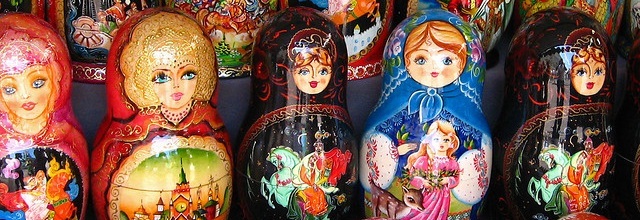The starting place to learn the Russian language on the Internet.
| FR | About us | Home | User agreement | Link to us |
Dual-language text: Matryoshka

Photo by neiljs / flickr cc-by-2.0
This page contains a dual-language article about Matryoshka. The English translation of the Russian text is as close to the source as possible. You can also read an extended English version of the article about matryoshka.
 |
Read this article online for free or make a small donation (1 USD) and download a PDF version now! PDF version is perfectly formatted for printing. |
Level: Intermediate to Advanced
Words: 425
Accents: Yes
1.
Сло́жно найти́ си́мвол Росси́и бо́лее популя́рный, чем традицио́нная ру́сская матрёшка. О матрёшке – деревя́нной расписно́й игру́шке «с секре́том» – зна́ют да́же в са́мых отдалённых от Росси́и стра́нах. Матрёшек везу́т домо́й тури́сты из Евро́пы и Аме́рики; матрёшек коллекциони́руют люби́тели экзо́тики в Австра́лии и Ю́жной Африке; матрёшки привлека́ют покло́нников наро́дного тво́рчества свое́й простото́й и оригина́льностью. Я́ркие живопи́сные матрёшки украша́ют ками́нные и кни́жные по́лки в дома́х ты́сяч россия́н.
It's difficult to find a symbol of Russia more popular than the traditional Russian matryoshka. The matryoshka doll - the wooden decorated toy "with a secret" - is known even in the countries most distant from Russia. Tourists from Europe and the USA bring matryoshka dolls back home; the lovers of exotics collect matryoshkas in Australia and South Africa; the simplicity and originality of matryoshka dolls attract the fans of Russian folk art. Bright and picturesque matryoshka dolls decorate the fireplaces and bookshelves in the homes of thousands of Russians (residents of Russia).
- матрёшка = matryoshka (Russian nesting doll)
- деревя́нный = wooden
- расписно́й = decorated
- отдалённый = remote, distant
- коллекциони́ровать = to collect
- покло́нник = a fan, admirer
- наро́дный = (adjective) folk
- тво́рчество = art
- живопи́сный = picturesque
- ками́нный = (adjective) fireplace
- кни́жная по́лка = a bookshelf
- россия́нин = a Russian national, resident of Russia (any ethnicity)
2.
Исто́рия матрёшки: награ́ды и популя́рность
Не́которые исто́рики ру́сского бы́та утвержда́ют, что матрёшка – э́то ко́пия япо́нской раскладно́й ку́клы. Одна́ко изве́стно, что задо́лго до появле́ния матрёшки ру́сские мастера́ де́лали разъёмные пусты́е внутри́ пасха́льные я́йца из де́рева. Пе́рвая деревя́нная матрёшка появи́лась в Москве́ в 90-х года́х ХХ века́. Она́ состоя́ла из восьми́ ку́кол, вло́женных одна́ в другу́ю. Ку́клы изобража́ли малыше́й, са́мым ма́леньким из кото́рых был новорождённый младе́нец.
Не́которые исто́рики ру́сского бы́та утвержда́ют, что матрёшка – э́то ко́пия япо́нской раскладно́й ку́клы. Одна́ко изве́стно, что задо́лго до появле́ния матрёшки ру́сские мастера́ де́лали разъёмные пусты́е внутри́ пасха́льные я́йца из де́рева. Пе́рвая деревя́нная матрёшка появи́лась в Москве́ в 90-х года́х ХХ века́. Она́ состоя́ла из восьми́ ку́кол, вло́женных одна́ в другу́ю. Ку́клы изобража́ли малыше́й, са́мым ма́леньким из кото́рых был новорождённый младе́нец.
History of matryoshka doll: awards and popularity
Some historians of Russian life argue that matryoshka doll is a copy of the Japanese detachable doll. However it's known that long before appearance of the matryoshka doll, Russian masters would make hollow detachable Easter eggs from the wood. The first wooden matryoshka doll appeared in Moscow in the 90's of the XX-th century. It consisted of eight dolls placed one inside the other. The dolls depicted children -- the smallest of which was a newly born baby.
Some historians of Russian life argue that matryoshka doll is a copy of the Japanese detachable doll. However it's known that long before appearance of the matryoshka doll, Russian masters would make hollow detachable Easter eggs from the wood. The first wooden matryoshka doll appeared in Moscow in the 90's of the XX-th century. It consisted of eight dolls placed one inside the other. The dolls depicted children -- the smallest of which was a newly born baby.
- исто́рик = historian
- бы́т = life
- раскладно́й = folding
- ку́кла = doll
- разъёмный = detachable
- пасха́льное я́йцо = Easter Egg
- вло́женный = nested
- новорождённый = newborn (новоро́жденный is a colloquial form)
3.
Пе́рвые матрёшки, хоть и де́лались для дете́й, сто́или так до́рого, что купи́ть их могли́ то́лько взро́слые. Матрёшки ча́сто станови́лись пода́рком де́вушкам от их возлю́бленных. В 1900 году́ на Всеми́рной вы́ставке в Пари́же ру́сская матрёшка получи́ла бро́нзовую меда́ль, и уже́ че́рез не́сколько лет матрёшки ста́ли безу́мно популя́рными. В Росси́и появи́лось не́сколько знамени́тых це́нтров по их изготовле́нию, са́мыми изве́стными из кото́рых ста́ли Се́ргиев поса́д и Семёнов. В нача́ле ХХ ве́ка матрёшек ста́ли ма́ссово вывози́ть за грани́цу, а в Герма́нии да́же появи́лись не́сколько компа́ний, кото́рые де́лали подде́льных матрёшек и продава́ли их как ру́сские игру́шки.
Although first matryoshka dolls were intended for children, they cost so much that only adults could afford to buy them. Matryoshka dolls were often given as a present to young women by their beloved ones. In 1900, Russian matryoshka earned a bronze medal at the World Exhibition in Paris, and just a few years later matryoshka dolls became insanely popular. Several well-known manufacturing centers appeared in Russia, the most famous of which became Sergiev Posad and Semenov. In the beginning of the twentieth century, Russian nesting dolls were being exported abroad in large quantities, and even a few companies appeared in Germany which produced counterfeit matryoshka dolls and sold them as Russian toys.
- сто́ить = to cost
- до́рого = expensive
- взро́слый = adult
- возлю́бленный = beloved, sweetheart (refers to a male)
- возлю́бленная = beloved, sweetheart (refers to a female)
- вы́ставка = exhibition
- безу́мно = madly, insanely
- вывози́ть за грани́цу = to export abroad
- подде́льный = fake, counterfeit
4.
Из чего́ и как сде́лана матрёшка
Над изготовле́нием матрёшек из берёзы и ли́пы труди́лись це́лые се́мьи. Ку́кол цилиндри́ческой фо́рмы распи́сывали по-ра́зному: э́то могли́ быть де́вушки в сарафа́нах и платка́х, мужчи́ны и́ли де́ти. Ча́сто в рука́х нарисо́ванные ку́клы держа́ли корзи́ны с я́годами, хлеб, буке́ты цвето́в.
Над изготовле́нием матрёшек из берёзы и ли́пы труди́лись це́лые се́мьи. Ку́кол цилиндри́ческой фо́рмы распи́сывали по-ра́зному: э́то могли́ быть де́вушки в сарафа́нах и платка́х, мужчи́ны и́ли де́ти. Ча́сто в рука́х нарисо́ванные ку́клы держа́ли корзи́ны с я́годами, хлеб, буке́ты цвето́в.
What from and how is the Russian matryoshka made?
Whole families were involved in production of matryoshka dolls from linden or birch. The dolls of the cylindrical form were painted in different ways: it could be girls dressed in a sarafan and a headscarf, men or children. Matryoshka dolls were often painted holding baskets of berries, bread, bunches of flowers.
Whole families were involved in production of matryoshka dolls from linden or birch. The dolls of the cylindrical form were painted in different ways: it could be girls dressed in a sarafan and a headscarf, men or children. Matryoshka dolls were often painted holding baskets of berries, bread, bunches of flowers.
- изготовле́ние = production
- берёза = birch
- ли́па = linden
- распи́сывать = to paint
- сарафа́н = sarafan
- платок = shawl
5.
Начина́ли изготовле́ние матрёшки с са́мой ма́ленькой ку́клы, кото́рая лежи́т в середи́не други́х и не разбира́ется на ча́сти. Коли́чество ку́кол могло́ быть ра́зным, от двух до шести́десяти, но класси́ческим счита́лся вариа́нт, когда́ матрёшка состоя́ла из пяти́ ку́кол. Когда́ все ку́клы бы́ли гото́вы, их покрыва́ли специа́льным кле́ем, кото́рый заполня́л ще́ли и неро́вности. А уже́ све́рху наноси́ли рису́нок.
The production of matryoshka would begin with the smallest doll which was placed inside all other dolls and did not come apart. The number of nested dolls (in a set) could vary from two to sixty however the classic version was considered to consist of five dolls. When all the dolls were ready, they were covered with special glue to fill the cracks and roughness, and the picture was pained on top.
- разбира́ться на ча́сти = one that can be taken apart
- вариа́нт = version
- покрыва́ть = to cover
- ще́ль = crack, gap
- неро́вность = roughness
6.
В не́которых ру́сских деревня́х по э́той техноло́гии вручну́ю де́лают матрёшек и сего́дня. Кста́ти, совреме́нные матрёшки ручно́й рабо́ты соверше́нно не токси́чны, потому́ что при их ро́списи мастера́ испо́льзуют акваре́ль, гуа́шь и те́мперу. Распи́сывают матрёшек по-ра́зному: встреча́ются матрёшки в ви́де геро́ев ру́сских ска́зок и́ли изве́стных полити́ческих и истори́ческих де́ятелей.
In some villages, nesting dolls are hand-made acccording to this technology even nowadays. By the way, contemporary hand-made matryoshka dolls are absolutely non-toxic because they are painted with watercolor, gouache and tempera.
The matryoshka dolls are painted differently: there are matryoshka dolls in the form of the heroes of Russian fairy tales or famous political and historical figures.
- деревня = village
- вручну́ю = manually
- ручно́й рабо́ты = handmade
- акваре́ль = watercolor
- де́ятель = worker, figure
7.
Матрёшки-рекордсме́ны: всеми́рный успе́х
В 1913 году́ на фа́брике в Семёнове сде́лали матрёшку, в кото́рую входи́ли 48 ку́кол, распи́санных в традицио́нных кра́сно-жёлтых тона́х. А са́мая больша́я матрёшка была́ предста́влена на вы́ставке в Япо́нии в 1970 го́ду. Ру́сские мастера́ из Семёнова привезли́ в То́кио матрёшку, кото́рая состоя́ла из семи́десяти двух ку́кол. Разуме́ется, изготовле́ние таки́х матрёшек тре́бует осо́бого мастерства́, поэ́тому их ма́ссовый вы́пуск невозмо́жен.
В 1913 году́ на фа́брике в Семёнове сде́лали матрёшку, в кото́рую входи́ли 48 ку́кол, распи́санных в традицио́нных кра́сно-жёлтых тона́х. А са́мая больша́я матрёшка была́ предста́влена на вы́ставке в Япо́нии в 1970 го́ду. Ру́сские мастера́ из Семёнова привезли́ в То́кио матрёшку, кото́рая состоя́ла из семи́десяти двух ку́кол. Разуме́ется, изготовле́ние таки́х матрёшек тре́бует осо́бого мастерства́, поэ́тому их ма́ссовый вы́пуск невозмо́жен.
Matryoshkas Record-breakers: worldwide success
In 1913, a factory in the city of Semyonov produced a matryoshka dolls set that consisted of 48 figures painted in traditional red and yellow colors. And the biggest matryoshka dolls set was presented at the exhibition in Japan in 1970. Russian masters from Semenov brought to Tokio a matryoshka set which conisted of seventy-two figures. Of course, the production of such matryoshkas requires exceptional mastery, therefore their mass production is not possible.
In 1913, a factory in the city of Semyonov produced a matryoshka dolls set that consisted of 48 figures painted in traditional red and yellow colors. And the biggest matryoshka dolls set was presented at the exhibition in Japan in 1970. Russian masters from Semenov brought to Tokio a matryoshka set which conisted of seventy-two figures. Of course, the production of such matryoshkas requires exceptional mastery, therefore their mass production is not possible.
- рекордсме́н = record holder, champion
- всеми́рный = worldwide
- успе́х = success
- разуме́ется = of course, certainly
- осо́бый = special
- вы́пуск = issue, output
Got questions?
Ask them in the Russian Questions and Answers — a place for students, teachers and native Russian speakers to discuss Russian grammar, vocabulary, pronunciation, and other aspects of the Russian language.
Copyright 2001-2026 MasterRussian.com | Privacy Policy | Contact Us
 Russian Lessons
Russian Lessons
- Russian alphabet
- Names of letters
- Russian Q&A new
- Pronunciation: Cons.
- Pronunciation: Vowels
- Noun Gender/Number
- Cases of Nouns
- Russian Greetings
- Personal Pronouns
- Learning Russian
- 1000 Common Words
- 500 Russian Verbs
- Top Russian Nouns
- » All lessons
- » Guest lessons
 Browse Topics
Browse Topics
- Start learning Russian
- Forum
- Bookstore
- Dictionaries
- Russian - basic
- Russian - adv
- Pronunciation
- Russian Blog new
- Reading
- Test & quizzes
- Translation
- Verbs
- Verb Conjugations
- Russian numbers
- Russian Tests new
- Vocabulary
- Writing
- Folk music
- Fun stuff
- Leo Tolstoy
- Learner's lore
- Literature
- Personal blogs
- Picture Dictionary new
- Proverbs
- Publications
- Radio & TV
- Russian culture
- Schools in Russia
- Russian Words
- Russian names
- Software
- Russian Words iPhone

Search MasterRussian

Custom Search
English » Russian dictionary

WORD OF THE DAY
![]() RSS
|
iGoogle
|
My Yahoo!
RSS
|
iGoogle
|
My Yahoo!
Meaning: where
Pronunciation: [gdyeh]
Learn Russian words more... »
TODAY'S STREET SIGN

Russian: Сбербанк России
English: Sberbank of Russia
FOLLOW US ON TWITTER

MasterRussian on Twitter


